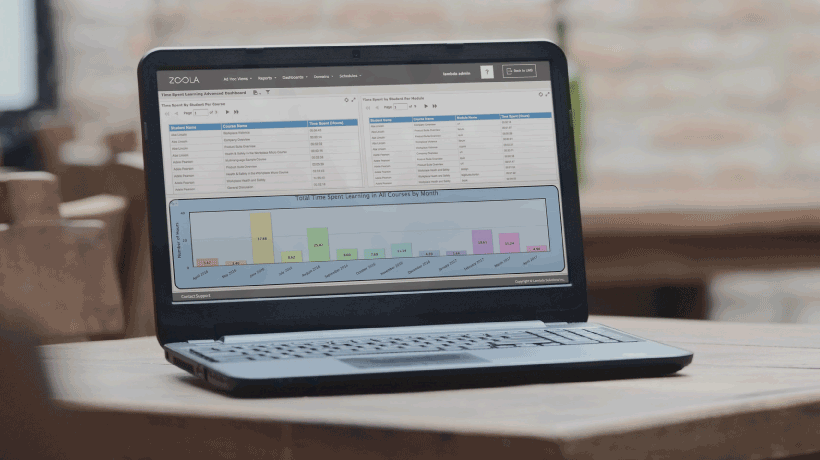Tapping Into The Potential Of Learning Data
In today's data-driven world, organizations are constantly seeking ways to optimize their processes, improve productivity, and maximize their Return On Investment (ROI). The realm of Learning and Development (L&D) is no exception. Learning data, encompassing various forms of information gathered during the training and development process, holds immense potential for transforming the way companies approach employee learning and upskilling. To unlock the full value of learning data in L&D, organizations must adopt a comprehensive and strategic approach, utilizing data analytics, personalized learning paths, continuous feedback loops, and data privacy measures.
Data Analytics: The Foundation Of Informed Decisions
Data analytics is the cornerstone of unlocking the full value of learning data by leveraging advanced data collection tools and methodologies to gather comprehensive insights into learners' behaviors, preferences, and performance. By analyzing this data, organizations can identify patterns, trends, and correlations that inform decision-making, such as refining course content, optimizing instructional methods, and predicting future learning needs. Data analytics enables L&D teams to move beyond a one-size-fits-all approach, making learning more targeted, efficient, and impactful. Organizations must leverage modern technology and Learning Management Systems (LMS) to collect and analyze data effectively. By examining training performance metrics, engagement levels, knowledge retention rates, and learner feedback, organizations can gain valuable insights into the effectiveness of their training programs. Analyzing this data can help identify knowledge gaps, bottlenecks, and areas for improvement, allowing L&D teams to optimize content and delivery methods. Additionally, organizations must ensure that their employees strengthen their data literacy skills [1] to navigate descriptive, predictive, and prescriptive data analytics. Predictive analytics can anticipate learning needs and adapt L&D initiatives accordingly, ensuring that the workforce stays ahead in a rapidly evolving business landscape.
Personalized Learning Paths: Tailored For Success
One size does not fit all when it comes to Learning and Development. Recognizing that each learner is unique, personalized learning paths are essential to unlocking the full potential of learning data. By tailoring educational experiences to individual needs, interests, and learning styles, organizations can foster higher engagement and motivation among learners. Personalization may involve adaptive learning platforms that use data analytics to dynamically adjust content and difficulty based on a student's performance or offer a diverse range of learning resources to cater to different preferences. To unlock the full value of learning data, organizations must embrace curating personalized learning pathways for learners. By capturing individual learner data, such as prior knowledge, learning preferences, and career aspirations, L&D teams can tailor training programs to meet the specific needs of each employee. Personalized learning paths empower employees to progress at their own pace and focus on relevant content, leading to increased engagement, knowledge retention, and skill acquisition. As a result, organizations can nurture a more agile and skilled workforce, ready to tackle new challenges and seize opportunities.
Continuous Feedback Loops: Fostering A Culture Of Growth
The value of learning data extends beyond training completion rates and test scores. Continuous feedback loops are pivotal in driving learner improvement and organizational success. Regular and constructive feedback helps learners gauge their progress, understand their strengths and weaknesses, and make informed adjustments to their learning approaches. Data analytics can facilitate this process by providing real-time insights into learner performance and engagement, enabling educators and trainers to intervene promptly when learners encounter challenges or require additional support. Engaging in continuous feedback loops enables organizations to gauge the impact of learning on job performance and overall business outcomes that drive growth [2]. Regular assessments and follow-up evaluations provide valuable information on the practical application of learned skills, enabling L&D teams to fine-tune training content and delivery methods accordingly. Moreover, feedback from learners helps to identify areas where additional support or resources may be required, fostering a culture of growth and development within the organization.
Data Privacy Measures: Safeguarding Sensitive Information
As organizations delve deeper into learning data analytics, they must be mindful of data privacy and security concerns. Safeguarding sensitive learner information is paramount. While leveraging learning data is essential for enhancing L&D outcomes, safeguarding data privacy is equally critical. Organizations must implement robust data privacy measures to protect learners' sensitive information from unauthorized access, breaches, or misuse. This entails complying with relevant data protection regulations and industry standards, securing data storage and transmission with encryption, and implementing strict access controls. By prioritizing data privacy, organizations can establish trust with learners and other stakeholders, ensuring that learning data is used responsibly and ethically to drive meaningful educational insights and improvements. Therefore, organizations should implement robust data privacy measures and comply with relevant regulations to protect learner identities and sensitive data. Transparency regarding data collection and usage practices is essential to gaining employees' trust and ensuring their willingness to participate in data-driven learning initiatives.
Integration With Business Strategy: Aligning Learning With Organizational Goals
To unlock the full value of learning data, L&D efforts should align closely with an organization's broader business strategy [3]. By integrating learning goals with key business objectives, organizations can ensure that training initiatives directly contribute to enhancing productivity, innovation, and overall performance. Data-driven insights can shed light on the skills and competencies required to drive business success, enabling L&D teams to design targeted programs that address these specific needs. This alignment fosters a stronger link between learning outcomes and business outcomes, facilitating buy-in from stakeholders and decision-makers.
Leveraging Emerging Technologies: The Power Of AI And The Metaverse
To stay at the forefront of Learning and Development, organizations must embrace emerging technologies that complement and enhance traditional training methods. Generative Artificial Intelligence (AI) [4] and the metaverse are technologies with tremendous potential for unlocking the full value of learning data. AI-powered chatbots and virtual tutors can offer personalized support and guidance to learners, while VR simulations provide immersive and experiential learning opportunities. These technologies generate vast amounts of data that can be harnessed to optimize learning experiences and drive performance improvements.
Conclusion
Unlocking the full value of learning data in Learning and Development requires a strategic and holistic approach. Organizations can harness the power of learning data by leveraging data analytics, tailoring learning paths, fostering continuous feedback loops, ensuring data privacy, aligning with business strategy, and embracing emerging technologies to create a skilled, agile, and high-performing workforce. Data-driven L&D initiatives not only empower employees to thrive but also enable organizations to stay competitive in an ever-evolving business landscape.
References:
[1] eLearning Skills 2030: Data Literacy
[2] Growth Blueprint: Planning For Performance








